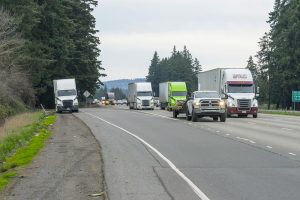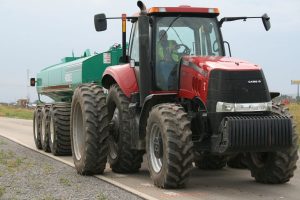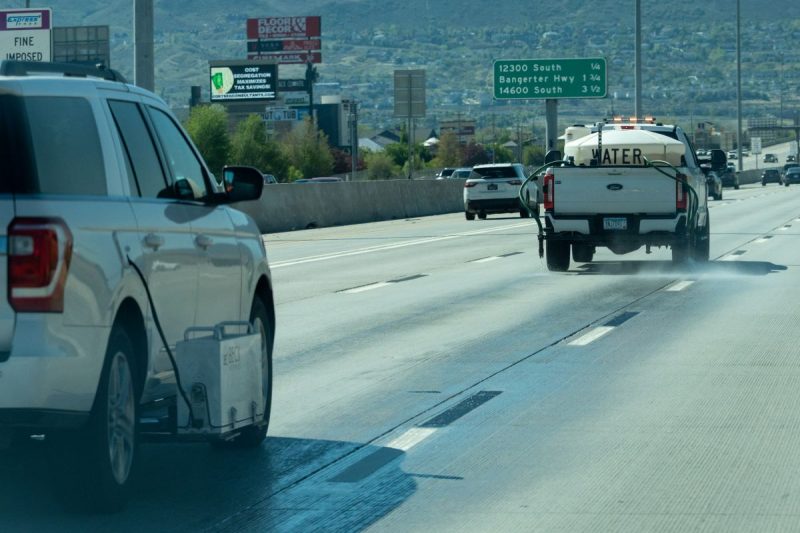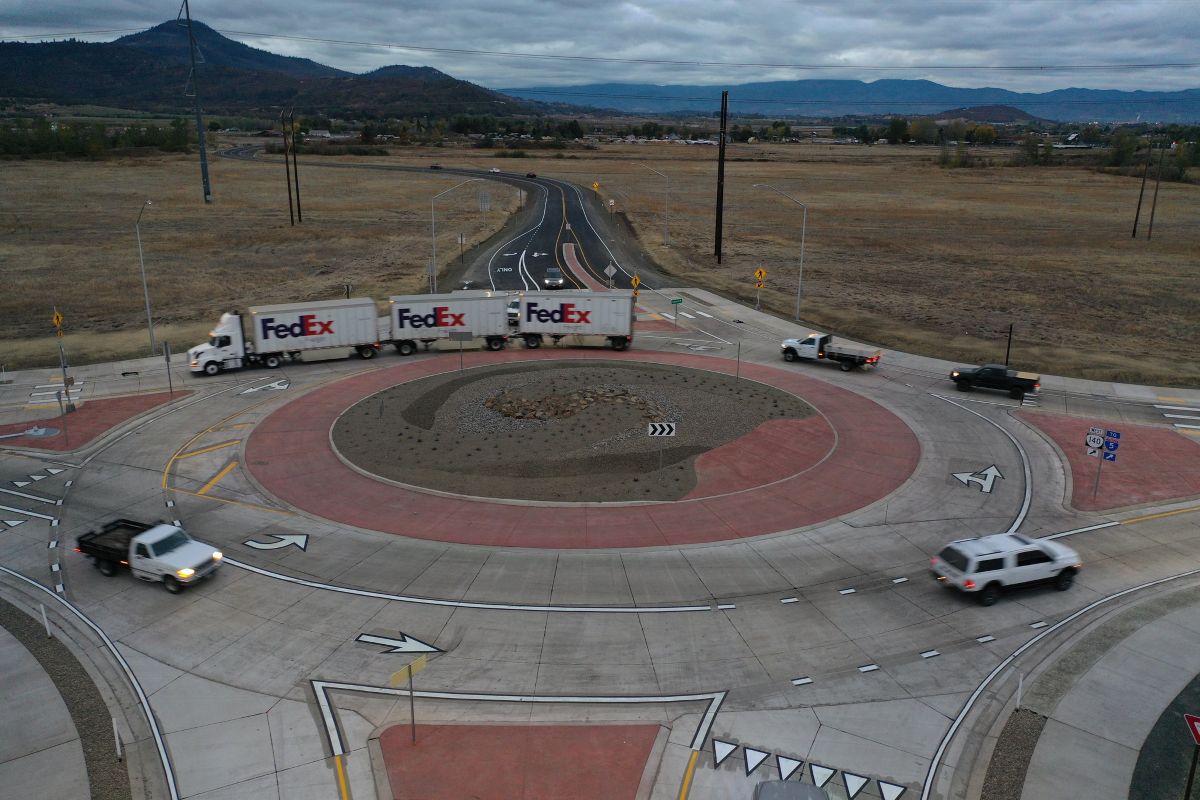 Courtesy of Oregon DOT
Courtesy of Oregon DOTTRB published National Cooperative Highway Research Program (NCHRP) Research Report 1043: Guide for Roundabouts—the latest version of what is commonly known as the Roundabout Guide—in June 2023. Managed by NCHRP and AASHTO, this report is the culmination of more than 25 years of applied research that advances roundabout planning and design.
The guide offers more than 400 pages of context- and performance-based guidance to help practitioners and industry professionals design and implement infrastructure that supports everyone who travels. It also has the potential to save lives.
Roundabouts offer numerous safety benefits, including reduced crash frequency and crash severity. The updated guide aligns with nationwide safety initiatives such as Vision Zero, a strategy to zero-out traffic fatalities and severe injuries for all roadway users, and the Safe System Approach. The latter is a holistic and comprehensive approach that works by building multiple layers of protection to prevent crashes from happening and minimizing the harm caused to those involved when crashes do occur. The guide offers readers data-driven tools and guidance that support the public’s health, safety, and well-being. Additional project details, as well as research and literature review findings, are provided in a supplemental publication: NCHRP Web-Only Document 347: Background and Summary of a Guide for Roundabouts.
This article highlights some of the latest guidance and key updates presented in the guide. For those new to roundabouts and roundabout research, the article also provides context on the history of this intersection type (Figure 1) and efforts to apply roundabouts to solve transportation challenges.
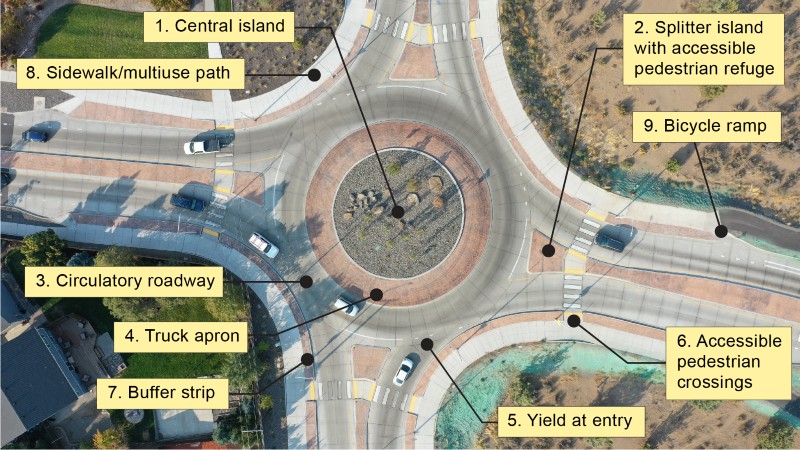
About the Guide
The guide is the latest of three successive national guides on roundabout planning and design in the United States. The series began with an FHWA publication titled Roundabouts: An Informational Guide (2000) and was last updated with NCHRP Report 672: Roundabouts: An Informational Guide, 2nd Edition (2010).
Information in the current guide represents the latest national guidance on transportation safety performance, operational performance, and quality of service. The guide applies to all road users, whether they travel on foot, by bike, in vehicles, or with a mobility device. The guide also supports universal design, which holds that infrastructure should be accessible to and usable by everyone. Information in the guide also facilitates the implementation of federal, state, and local goals and policies, such as Vision Zero, the Safe System Approach, the Americans with Disabilities Act, and the Bipartisan Infrastructure Law (also known as the Infrastructure Investment and Jobs Act).
What’s New?
The updated guidance in NCHRP Research Report 1043 draws on the latest industry safety and capacity knowledge, as well as findings from other recent NCHRP research efforts. The guide has a new organizational scheme to help readers find what they need, when they need it, more easily. It also describes roundabouts according to their characteristics and function rather than by a specific type or name. This shift reflects continued advances in roundabout planning and design practice and how the guide has been adapted to better meet user needs.
New Research Efforts
An exciting aspect of the updated roundabout guide is that it contains the findings of distinctive research inquiries and large distillations and summaries of industry knowledge. New contributions to this edition of the guide include the following:
- Program-level policy and practice considerations, such as Vision Zero, the Safe System Approach, Roundabouts First policies (a practice in which an agency will consider a roundabout before any other intersection form, typically to promote implementations for their safety benefits), and intersection control evaluation;
- Expanded performance-based evaluations, which consider intersection location, project type, context classification, and community needs;
- Updated safety and operational performance evaluation techniques from the AASHTO Highway Safety Manual, 1st Edition, and TRB’s Highway Capacity Manual, 7th Edition;
- Refined design vehicle assessments—those of the most common vehicle that will use a roundabout—that provide a balanced roundabout design, including space or features to fit a larger check vehicle (a less common user of roundabouts, such as large farm equipment or a tractor–trailer) while maintaining the ideal size for common design vehicles and safe roundabout speeds;
- Revised intersection and stopping sight distance measurements to include pedestrian waiting areas;
- Tactile walking surface indicator information for pedestrians who are blind or have low vision;
- Pedestrian and bicycle facility examples that show different combinations of on-street, separated, and shared facilities;
- Techniques for designing roundabouts in a high-speed location to maintain appropriate roundabout entry speeds;
- Turbo roundabout—a multilane roundabout that keeps drivers in their intended lanes—treatments and features;
- Traffic control devices by area of roundabout rather than by type of device; and
- Photos of traffic control devices at roundabouts that help the reader understand roundabout design visually.
The guide also includes updated content based on the study team’s literature review and summary of industry practice, including guidance on the following:
- Mini-roundabouts and compact roundabouts;
- Traffic control devices, including metering signals, roundabouts at or near railroad crossings, and pedestrian crossings on roundabouts; and
- Updated lighting guidelines to increase design flexibility.
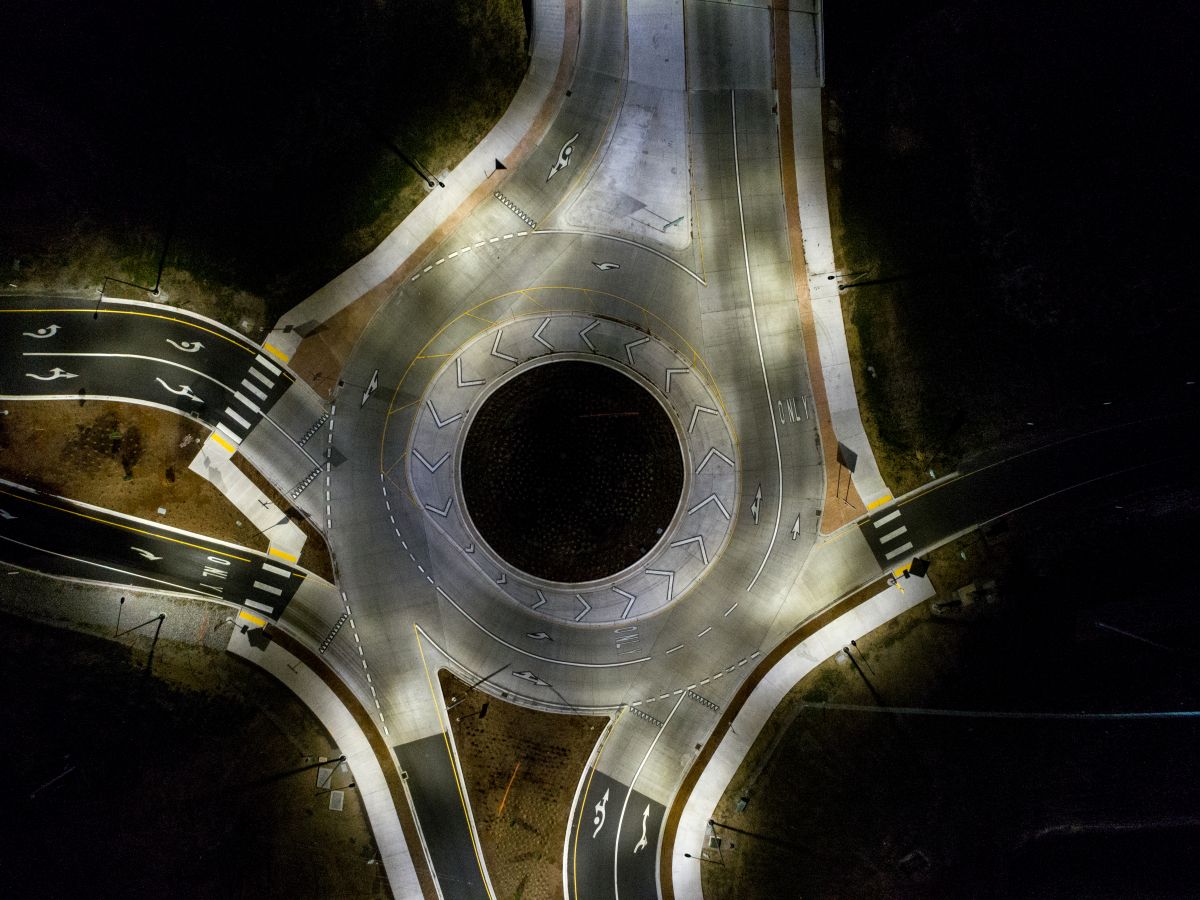 Courtesy of Kittelson & Associates
Courtesy of Kittelson & AssociatesNew and Updated Guidance
Some of the biggest updates to the guide include information on pedestrians and bicyclists, trucks and oversized vehicles, multilane roundabouts, intersection control evaluations (ICE), and retrofitting existing circular intersections. Guidance for these sections came from findings and new research conducted to fill gaps not covered by other research projects from NCHRP, FHWA, and other groups.
Pedestrians and Bicyclists Information and data for the guide’s update came from a state-of-the-practice review and virtual field reviews of bicycle facilities led by the research team. The reviews resulted in the inclusion of features and elements from a wide range of contemporary domestic and international design practices.
Documented in detail in NCHRP Research Report 948: Guide for Pedestrian and Bicyclist Safety at Alternative and Other Intersections and Interchanges, the 20 Design Flags method evaluates pedestrian and bicyclist safety and comfort at all types of intersections. Each design flag correlates with degraded safety performance or comfort. Practitioners use these flags to evaluate and compare alternatives at the planning level. This assessment helps practitioners screen out less promising alternatives across all modes of travel and incorporate geometric design features that promote pedestrian and bicyclist safety.
The updated roundabout guide also offers guidance for assessing and designing pedestrian wayfinding and crossings for people who are blind or have low vision. Wayfinding and crossing intersections can be challenges for people with impaired vision. The guide offers insights and principles on meeting these users’ needs that planners and designers can make use of to inform specific decisions related to the following four actions that pedestrians do to safely cross an intersection:
- Determine the appropriate crossing location,
- Align in the intersection while waiting for a gap to cross (and establish the correct heading across the crosswalk),
- Determine when to cross, and
- Maintain the heading while crossing.
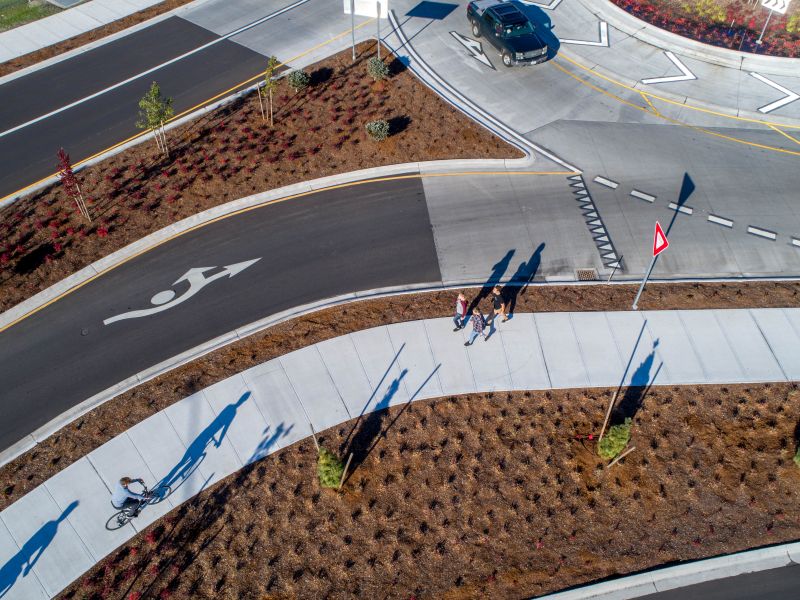 Courtesy of Kittelson & Associates
Courtesy of Kittelson & AssociatesTo help pedestrians who are vision-impaired, the guide provides applications for tactile walking surfaces. Tactile surfaces are specialized textured surfaces that warn a person of hazards or help them follow an intended path, stay out of bicycle facilities at the same elevation as the sidewalk, find a crossing that may be in an unexpected location, or align to cross.
Roadways often include a mix of pedestrian and bicycle facilities, such as on-street bike lanes, shared paths, or separated bicycle facilities. To account for these varied uses, the updated guide provides a principle-based approach and numerous application examples so practitioners can integrate the full range of pedestrian and bicycle facilities into roundabout designs and customize crossing types to reduce exposure and conflicts between all user types.
More and more, bicycle facilities are designed according to a bicyclist’s comfort level. This can range from occasional cyclists to expert riders who are comfortable riding among vehicles in traffic. Increasingly, planners and engineers design for the “interested but concerned” category, a group that is eager to bike but may need protection and separation to feel comfortable enough to do so. To help practitioners select and design facilities that support pedestrians and bicyclists, guidance focuses on the following:
- Reduce speed at conflict points (locations where two users may collide);
- Separate modes of travel;
- Clearly communicate who has the right-of-way;
- Provide predictable, simple, direct alignments;
- Allocate comfortable space for users to wait and make decisions; and
- Provide continuity with the adjoining pedestrian and bicyclist facilities.
For example, in the intersection depicted in Figure 2, pedestrians and bicyclists have separate crossing areas to reduce conflicts with motorists entering and leaving the roundabout.
![Illustration of a multilane roundabout with pedestrian crossings and one-way separated bicycle lanes shows the following features: dark grey for D W S (Detectable Warning Surface), light grey lines for T D I (Tactile Directional Indicator), and dotted lines for T W D (Tactile Warning Delineator). The roundabout has a sidewalk of 5 feet (1.5 meters) minimum on either end of the road. The multilane shows 2 travel lanes for each up and down direction. The bike lane of 5 feet (1.5 meters) minimum is between the sidewalk and travel lane on both sides. The space in the middle between the 2 opposite travel lanes is the landscaping or other nontraversable surface (typical). Between the sidewalk and the bike lane, the dotted line on both sides is marked as landscaping or other nontraversable surface (typical) if 2 feet (0.6 meters) or greater; T W D if less than 2 feet (0.6 meters). The pedestrian crosswalks have 3 pairs of grey lines marked as D W S. The distance between the D W S is marked as "a," where "a" is equal to 6 feet (1.8 meters) minimum [8 feet (2.4 meters) minimum with T D I].](https://trnews.org/wp-content/uploads/2025/06/FIGURE-2.jpg)
Trucks One of the most challenging aspects of roundabout design is balancing the needs of pedestrians, bicyclists, passenger vehicles, trucks, and other users. Because of their large size, trucks are a major factor when designing multilane roundabouts. To improve roundabout design for trucks, the study team conducted research to address how truck drivers use multilane roundabouts, including a state-of-the-practice review and an assessment of driver behavior through truck industry outreach and field observation.
Historically, to serve large trucks at multilane roundabouts, some states have adopted a series of design cases, differentiated by whether trucks straddle lanes on entry within the roundabout, stay in their lane on entry but then straddle lanes within the roundabout, or stay in their lane throughout. However, the study team found that truck drivers often mistakenly straddle lanes in roundabouts where the design intends trucks to stay in their lane. Sizing all roundabouts to serve trucks creates roundabouts with larger overall dimensions. These larger dimensions can generate faster passenger-car speeds, longer pedestrian crossings, increased construction costs, and larger right-of-way impacts.
The updated guide suggests that practitioners designing roundabouts for trucks use a straddle-lane configuration as the default (Figure 3). If appropriate, based on intersection conditions, specific movements can be configured for trucks to stay in their lanes. This approach is anticipated to reduce the overall footprint of multilane roundabouts and make them more economical without losing effectiveness. Rightsizing a roundabout (not overbuilding a configuration but tailoring the design to meet user needs and performance objectives) allows it to serve its intended users with a smaller footprint and at a lower overall cost.

Safety, Operational, and Design Performance The updated guide includes expanded roundabout guidance to reflect what industry professionals have learned about roundabout operations and safety performance since NCHRP Report 672 and other research efforts. Key highlights in the guide include the following:
- Project-level principles for conducting safety and operational performance analysis,
- Updated conflict point figures to explain the differences among various multilane configurations, and
- Refined design vehicle assessments to differentiate between a common design vehicle (“designing for” this more common vehicle) and a larger check vehicle (“accommodating” this less frequent vehicle).
The guide’s updated safety analysis reflects practices and findings from the AASHTO Highway Safety Manual, 1st Edition and NCHRP Research Report 888: Development of Roundabout Crash Prediction Models and Methods. The guide’s updated operational analysis guidance reflects TRB’s Highway Capacity Manual, 7th Edition.
Intersection Control Evaluation ICE is a performance-based approach that practitioners use to select appropriate performance measures and evaluate facility alternatives based on project context. With ICE, practitioners can advance solutions that have the potential to provide the highest benefit for project, community, and agency goals.
The updated guide provides a general overview of ICE activities and their relationship to roundabout planning and design. It offers practitioners an evaluation framework for selecting a preferred intersection control type—such as stop, yield, or signal—and configuration.
Retrofitting Existing Circular Intersections There are many older or existing roundabouts throughout the country that could benefit from safety and operations improvements. The guide illustrates real-world examples that demonstrate how the principles of the guide can be applied to existing roundabouts and traffic circles during any stage of the project development process. Readers will find information on how to identify roundabout design features and characteristics that contribute to undesirable performance and what modifications may help address those issues.
Sight Distance In the past, roundabout designers set the stopping sight distance for a driver preparing to enter a roundabout and a pedestrian in the crosswalk of the adjacent leg. The updated guide now sets sight distance to where pedestrians wait to cross (Figure 4). This expanded sight distance gives drivers more time to see pedestrians at the intersection and more time and distance to yield so pedestrians may cross safely.
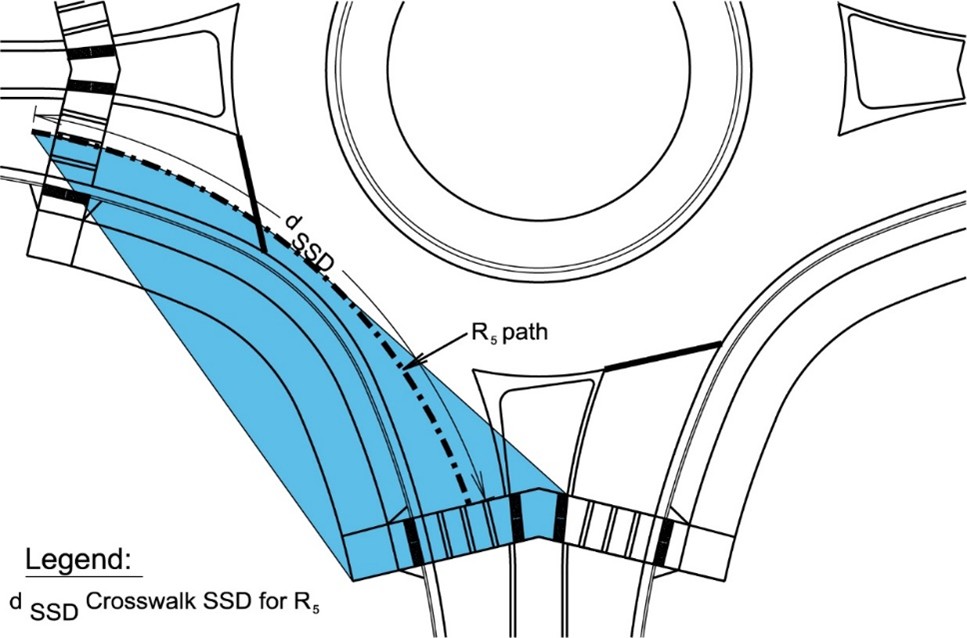
Guide Organization
The guide has a revised structure to help readers more easily and intuitively access the updated information. Practitioners need specific design guidance at each of the following stages of the project development process:
- Planning;
- Alternatives identification and evaluation;
- Preliminary design;
- Final design; and
- Construction, operations, and maintenance.
Decisions made early in the process have important implications for the eventual construction, operations, and maintenance of a site. Integrating design considerations into the planning phase also eases project implementation. To help professionals navigate these decisions, the updated guide is organized into five major parts according to each stage of the project development process (Figure 5). Each part is then subdivided by topic.
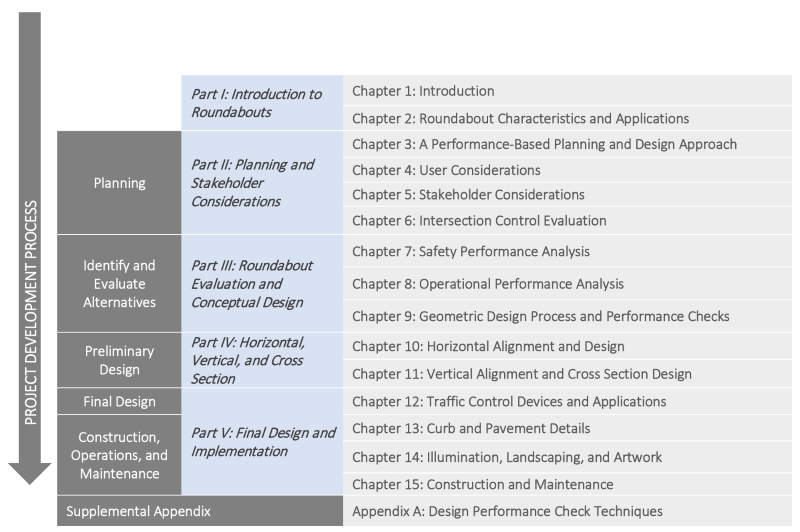
Context-Sensitive Approach
The updated guide expands upon the iterative, performance-based decision-making process that was the foundation of the original 2000 FHWA guide. Performance-based models are anchored in understanding and documenting intended project outcomes. These models focus on two central questions: Who are we trying to serve? and What are we trying to achieve? To answer these questions, practitioners must establish the existing context and future desired context, as well as identify critical project information, including project characteristics, type, influences, and development stage. Together, this context will set the foundation for all subsequent planning and design decisions.
The updated guide offers practitioners a performance-based and context-sensitive approach that can be scaled to any project development stage. This approach encourages flexible, adaptable designs for a given project context. Figure 6 outlines the guide’s framework for determining project context, the first step in the roundabout design process.
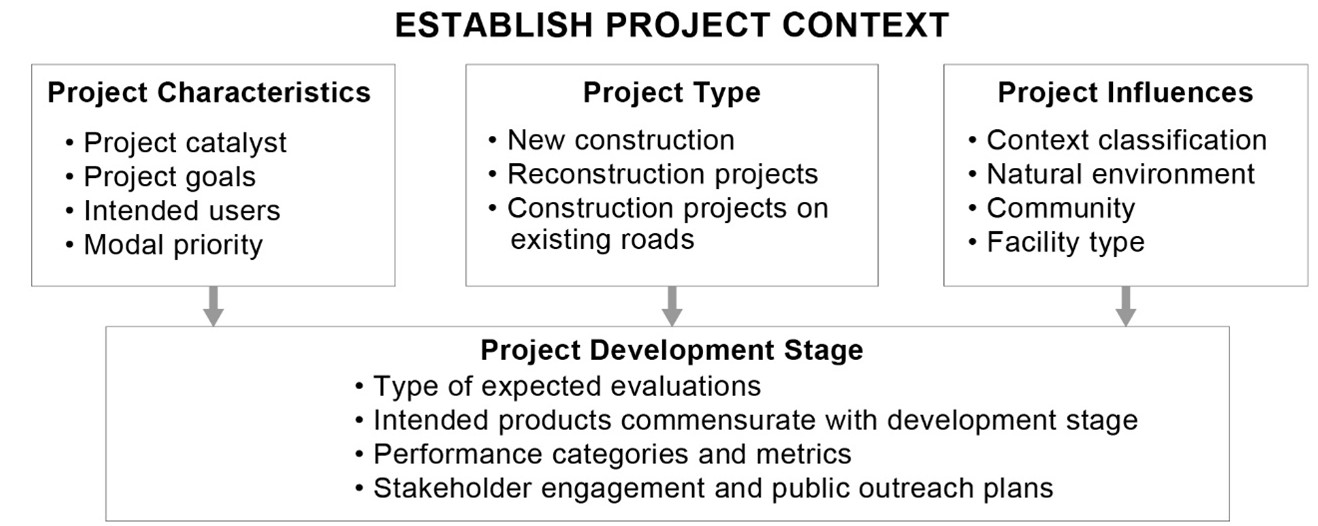
Transportation infrastructure is often an integral component of land use, community, or economic development or revitalization plans. The updated guide’s design process expands potential project outcomes beyond intersection safety, operational performance, and multimodal performance to include transportation access for all.
Roundabout History and Research Record
Roundabout implementation in the United States has accelerated over the past 30 years. In 1998, there were only 50 known roundabouts. Today, a crowdsourced online database supports an estimate of more than 10,000 roundabouts (Figure 7) (1).

Circular intersections, however, are not new. In fact, traffic circles and rotaries have been part of the roadway network in the United States for more than a century. At their start, traffic circles served both transportation and land-use purposes. Central islands sometimes included park areas or civic plazas that required pedestrian access. Parking was often allowed within the circulatory roadway, first for horse-drawn vehicles and later for automobiles.
One of the first official circular intersection guidebooks was A Policy on Rotary Intersections, published by AASHO—the American Association of State Highway Officials and the precursor to AASHTO—in 1942. The prevailing designs theoretically enabled free-flow operations. Larger footprints were seen as a benefit because they provided more space for merging and weaving. However, larger rotaries resulted in higher circulating speeds and increased crash severity. Some designs even prioritized entering vehicles over circulating vehicles, which created queues inside the circulatory roadway that blocked upstream exits and entries. Rotaries fell out of favor in the United States and abroad after the mid-1950s because of their high crash frequency and congestion. To fix these problems, the UK implemented designs that forced vehicles to yield on entry and to travel at slower speeds, improvements that reduced crash frequency and severity.
Modern roundabouts are a specific type of circular intersection. Their geometric features maintain slower, more consistent vehicle speeds. Slower speeds decrease the likelihood of conflicts between users and reduce crash risk.
In a roundabout (unlike a traffic circle or rotary), traffic flows counterclockwise and entering drivers yield to circulating vehicles. If present, pedestrian access and crossings are located at roadway approaches rather than the central island. Vehicles are not permitted to park in the circulatory intersection.
History of Roundabout Guidance
In the United States, roundabout guidance has naturally grown alongside the expansion of the roundabout (Figure 7). As this guidance has grown, it has had a ripple effect on research and guidance across transportation planning, safety, operations, and design. For example, the first U.S. roundabout guide introduced an iterative evaluation process to confirm that a roundabout design achieved a low target speed. This process preceded the expanded performance-based design process in NCHRP Research Report 1043, which offers performance measures valuable for also assessing nonroundabout intersection forms.
FHWA provided the first national roundabout guidance in 2000 with a publication called Roundabouts: An Informational Guide. This guidance was largely based on international roundabout practices that the agency adapted to established requirements and practices in the AASHTO A Policy on Geometric Design of Highways and Streets, the Manual on Uniform Traffic Control Devices (MUTCD), and the Americans with Disabilities Act (1990).
As the number of roundabouts increased, so did the need for design guidance that reflected observed and desired behavior in the United States. In response, NCHRP documented traffic operations and safety performance at the national scale in NCHRP Report 572: Roundabouts in the United States (2007) and updated the roundabout guide with NCHRP Report 672: Roundabouts: An Informational Guide, 2nd Edition (2010).
Over the same period, TRB integrated and updated roundabout-specific traffic operations methodologies in the Highway Capacity Manual (2010); AASHTO documented roundabout crash modification factors in the first Highway Safety Manual (2010); and FHWA expanded roundabout signs and pavement markings in the 2009 MUTCD.
Since the first wave of roundabout guidelines in the early 2000s, NCHRP, FHWA, and AASHTO have sponsored many new research inquiries to address specific knowledge gaps. In addition to numerous studies on mini- and turbo roundabouts, key projects included the following:
- NCHRP Report 772: Evaluating the Performance of Corridors with Roundabouts;
- NCHRP Research Report 834: Crossing Solutions at Roundabouts and Channelized Turn Lanes for Pedestrians with Vision Disabilities: A Guidebook;
- NCHRP Research Report 888: Development of Roundabout Crash Prediction Models and Methods;
- NCHRP Research Report 948: Guide for Pedestrian and Bicyclist Safety at Alternative and Other Intersections and Interchanges;
- NCHRP Web-Only Document 220: Estimating the Life-Cycle Cost of Intersection Designs;
- NCHRP Synthesis 488: Roundabout Practices;
- Policy on Geometric Design of Highways and Streets (Green Book), 8th Edition (in process) (AASHTO);
- Accelerating Roundabout Implementation in the United States, Volume II or VII: Assessment of the Environmental Characteristics of Roundabouts (FHWA); and
- Reasons for Drivers Failing to Yield at Multilane Roundabout Exits (FHWA Pooled Fund Study).
Some of these documents are generalized to all types of intersections. Performance-based methods to evaluate and choose all intersection forms can be applied to roundabouts. Likewise, roundabout-specific applications can improve the evaluation of all intersection forms. In this way, research to understand one type of intersection often advances the field for many others.
What’s Next?
NCHRP Research Report 1043 brings together the latest roundabout research, best practices from the field, and advancements in transportation technology. Its principles apply broadly to roadways and intersections beyond roundabouts. Since the first U.S. roundabout guide, performance-based evaluations have become part of the general roadway and intersection planning and design practice. The principles and approaches in the updated guide will be applied to other roadway and intersection forms. Roundabout planning and design guidance can lead the profession in overall roadway and intersection planning and design.
Like a roundabout, the research process is a circle. Though the updated guide represents an exciting milestone in intersection planning and design, continued research is needed—domestically and internationally—to propel the industry forward. NCHRP, AASHTO, and FHWA help advance transportation planning and design through their cooperative efforts to conduct peer-reviewed, applied research—a vital contribution in the quest to improve the public’s safety, health, and welfare. NCHRP Research Report 1043 is an important step along the way.

